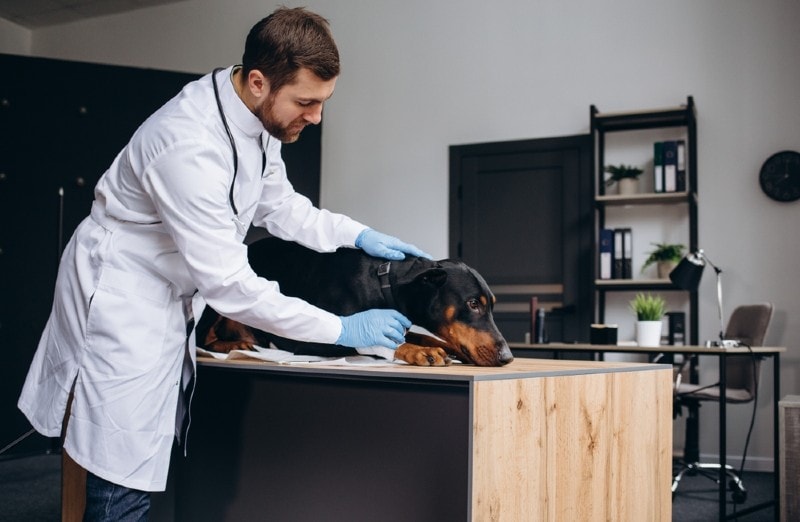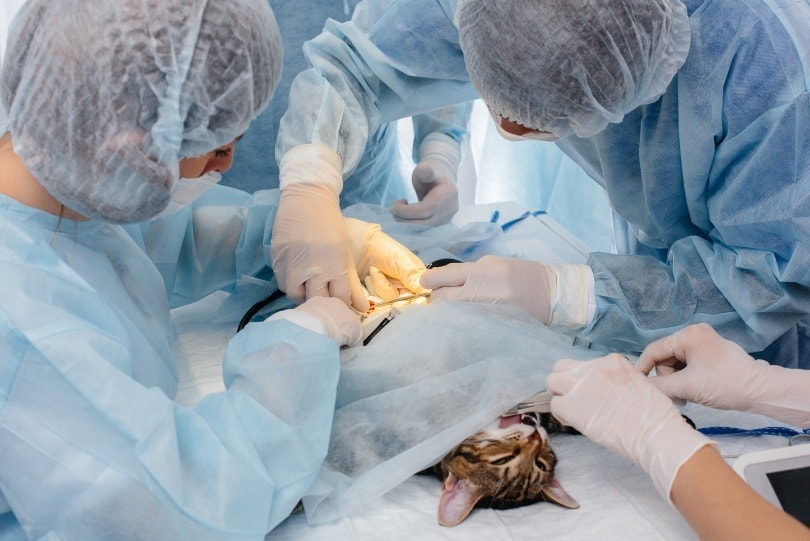My Dog Ate Packing Peanuts: Here’s What to Do (Vet Answer)

Updated on

Click to Skip Ahead
Packing peanuts are often used to help cushion and protect the inside of boxed shipped material and can be made of either a plastic polystyrene or a biodegradable starch-like material. Depending on the material of the packing peanut(s), the size of the dog, and the amount consumed, they can be a potentially problematic item for dogs to eat!
In this article, we’ll discuss some tips on what to do if this happens, what to expect, and how to handle a life-threatening situation if your dog is choking on packing peanuts. Let’s get started.
Things to Do:
- Remove any other remaining material and set aside out of the reach of your pet.
- Get specific veterinary medical advice depending on your pup’s specific situation. You can contact your veterinarian or local emergency veterinary clinic. In addition, veterinary poison control options can include Pet Poison Helpline or the ASPCA Poison Control. Because these companies are always open and employ veterinary specialists in toxicology, they can advise pet parents with recommendations if something has been eaten that’s not supposed to, such as packing peanuts.
- If you can determine what kind of packing peanut was eaten (tip: biodegradable ones can dissolve in water while non-biodegradable ones can’t) and estimate how much your dog ate or got into, this will help determine the next steps.

Things Not to Do:
- Don’t panic! Remain calm so you can be available to care for your dog quickly and efficiently if need be.
- Don’t ignore the situation. At a very minimum, you’ll want to discuss the situation with your veterinarian, even if they only recommend watching your dog for any signs of illness, choking, or foreign body obstruction for the next several days. If there are medical concerns, seek further care promptly.
- Do NOT induce vomiting in your dog without the approval and instruction of a veterinarian. They will need to evaluate the situation with the item in question, the dog who is affected, the timing of consumption, etc. Some substances, including packing peanuts, could also be a choking hazard and so inducing vomiting could actually potentially cause choking.
Emergency Choking and How to Handle It
In general, it may be a good idea to have some background knowledge of emergency life-saving techniques should the need arise. Because any type of packing peanut could also be a potential choking hazard (either in going down or coming back up), we’ll discuss some ways to help should you find your dog choking.
First, some choking signs to be aware of include coughing, having trouble breathing, gasping for air, pawing at their face, excessive drooling, or acting panicked. A dog can also lose consciousness and you may find that their gums change from a normal pink hue to a blue or white color. If you see your dog choking with the above symptoms, this is an emergency!
So, if observed, what should you do? First, if there is anyone that may be around to whom you can call out for help, they may be able to provide invaluable aid as they could call a nearby veterinary clinic, switch off providing care with you for your dog if needed, or even give a car ride to you and your pet to the nearest available hospital.
Secondly, if you would like to attempt to remove the object (packing peanut or otherwise), from the dog’s mouth, below are some helpful steps. The caveat is to make sure you do not get bitten in the process, and that you do not push the item further back into the dog’s throat.
- You can pull the dog’s tongue out towards yourself and use your hand to carefully pull out the object.
- Alternatively, you may open the dog’s mouth and use sweeping motions with your fingers to grab the item in question and pull it outward.
- You could also try to use an item such as tweezers or tongs to attempt to obtain the item.
If these attempts are not successful, additional life-saving actions are the Heimlich Maneuver and perform Cardiopulmonary Resuscitation (CPR).
What Are Packing Peanuts?
This product is often used as fill material to help protect fragile objects that are being moved, stored, or shipped. Other common names they may go by include packing noodles, foam peanuts, foam popcorn, etc. Despite the specific shape, the packing material can become more compressed to fill in and around objects as needed. Many times, they are in the shape of a peanut (hence the name!), but they are also available in other shapes such as an S or noodle shape.
The product is most commonly available in two types. One is a non-biodegradable polystyrene or Styrofoam, made of plastic. The other type is biodegradable and is made up of a plant-based material, such as corn or potato starch. Even though it is made of plant material, it is important to note that it is not considered food-safe. The advantage of biodegradable packing peanuts is that they can dissolve in water and are therefore more environmentally friendly. Secondly, they are considered non-toxic if accidentally ingested by, say, a mischievous tail-wagging pup!
Packing Peanut Consumption Expectations and Management
If your dog eats packing peanuts a few items will come into play. How large is your dog? How many packing peanuts did they eat? What type of material are the packing peanuts made of? As you can imagine, a situation where a Labrador Retriever eats one biodegradable packing peanut will likely fare a little differently than the Chihuahua who ate 25 non-biodegradable packing peanuts.
Some of the big problems could be that they are a choking hazard, give an upset stomach, or even become a foreign body obstruction. Thankfully, if a small amount of biodegradable packing peanuts is eaten, the likelihood of a problem is much less present than non-biodegradable packing peanuts that aren’t digestible. For non-biodegradable packing peanuts, the quantity and size of the dog will come into play.
If you are looking for signs that your dog may have a foreign body obstruction or other gastrointestinal issue due to packing peanut consumption, look for continual vomiting, not wanting to eat, a painful abdomen, lethargy, weakness, or depression. A foreign body obstruction is a medical emergency. When there are severe medical issues, it’s recommended to seek treatment promptly, as the longer a dog is sick, the more likely they can have complications or an unfavorable outcome.
If a small amount of non-biodegradable packing peanuts is consumed, it’s recommended to follow your veterinarian’s medical guidance. Depending on the situation, radiographs may be recommended. Removal of several or many non-biodegradable peanuts may be able to be done with endoscopy (using a long flexible tube and camera that can visualize and attempt to obtain the sample in question) or a surgery called a laparotomy (exploratory surgery into the abdominal area) may be needed to remove the obstruction.
If a dog needs treatment and receives it early and successfully, they can have a good outlook. With an obstruction that is treated before a dog is very ill, the prognosis can also be favorable. But, if the dog is very ill and there is a delay in treatment, there can be a more guarded prognosis.

Prevention
If you are buying the packing peanuts yourself, whenever possible, try to get biodegradable ones. If you receive packaging with packing peanuts, make sure they get put away promptly out of the reach of your canine companion to avert a potential crisis altogether.
Conclusion
If your dog eats packing peanuts, there are several factors at play that will determine your next recommended steps. The type and quantity of the item as well as the size of your dog are key components. A small amount of biodegradable packing peanuts will likely have a better outcome than a box full of non-biodegradable packing peanuts.
As always, it’s best to contact your dog’s veterinarian to inform them of the situation and to get their recommended medical opinion on the next step.
See Also:
- My Dog Ate a Lizard: Vet-Approved Advice & FAQ
- My Dog Ate a Slug: Here’s What to Do (Vet Approved Advice)
Featured Image Credit: Urban by Habit, Shutterstock











